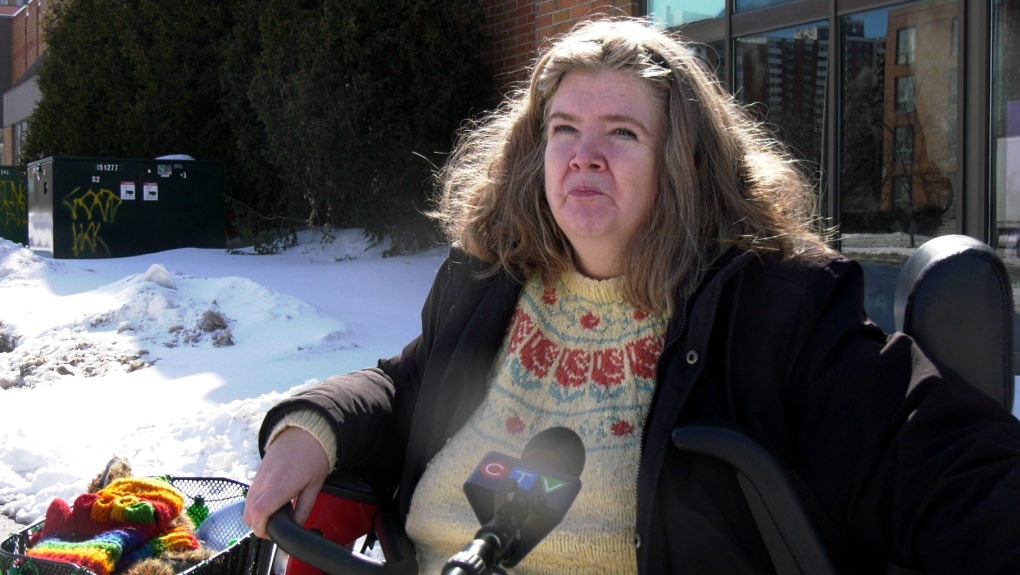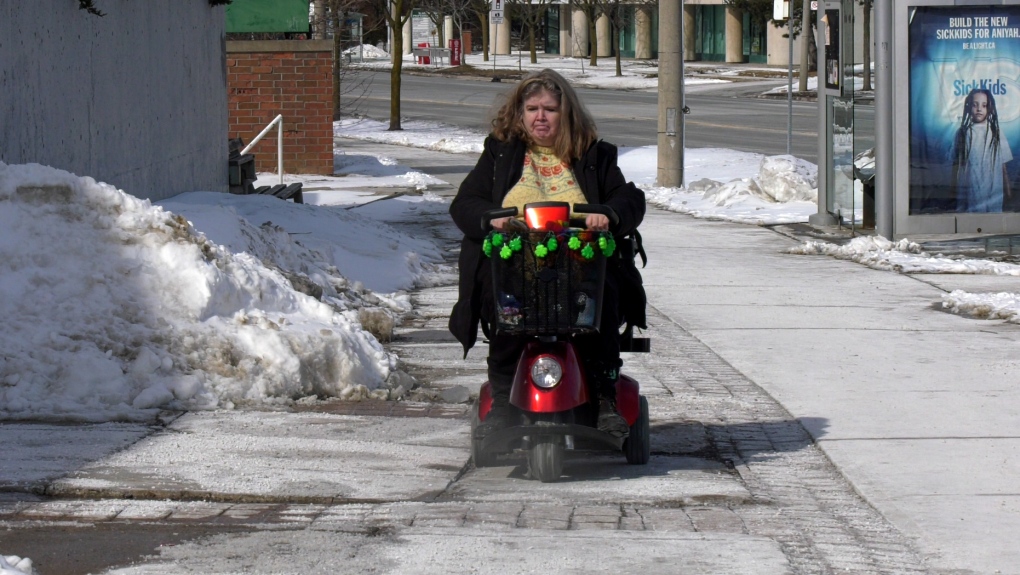Toronto woman who suffered concussion after fall from mobility scooter says city snow clearing protocols need review
A Toronto woman she says fell from her mobility scooter and got a concussion due to a poorly cleared sidewalk while trying to get groceries about ten days after the city saw a major snowfall in January.
Susan Hutchinson is calling for city crews to prioritize people with disabilities in the clearing of snow and make sure that when they do clear the path, what they leave behind is accessible — a recommendation echoed by a city committee this month.
“The sidewalk wasn’t cleared and I was going over really rough terrain,” she said. She said she was headed to get groceries near Malvern Town Centre on Jan. 28.
Hutchinson said she was following the path of a city plow that had veered off course and onto the uneven pavers on the mall’s property. She said her wheels slipped and she tumbled out of the scooter, receiving a concussion from the fall.
“It was sheer panic. I already have a spinal disability. I was nearly paralyzed once. My first thought was, ‘Cover my head.’”
 Susan Hutchinson (Jon Woodward/CTV News Toronto)
Susan Hutchinson (Jon Woodward/CTV News Toronto)
The City of Toronto confirmed it received a complaint from Hutchinson about her fall.
“The Municipal Licensing and Standards is investigating and addressing the damaged condition of the cobblestone path and concrete sidewalks, which are on private property. Since this is an ongoing investigation, additional information cannot be provided at the moment,” a city spokesperson said in a statement to CTV News Toronto.
The statement said all property owners are required to repair and maintain their property, and clear ice and snow within 24 hours after snowfall ends. Malvern Town Centre didn’t respond to inquiries from CTV News Toronto.
The City of Toronto previously said crews and contractors were working 24 hours a day to dig the city out of the January snowfall, which was the most snow seen in at least a decade. Cold weather meant the snow did not melt, and so tens of thousands of tonnes had to be trucked away.
 Susan Hutchinson (CTV News Toronto)
Susan Hutchinson (CTV News Toronto)
After the snowfall, those with mobility challenges had to make a choice: take the risk of going outside in a potentially hazardous situation or stay home.
“It was almost impossible,” Jean Williamson, who uses a mobility scooter, told CTV News Toronto Monday. “This is the first time in six weeks I’ve been able to get out on my own.”
Toronto’s Accessibility Advisory Committee is calling for the city to target areas that people with mobility issues or seniors use, to respond quickly to service requests even during “black-out” periods, and to have standard levels of service for major winter storms that leave huge amounts of snow.
“Rather than let it be chaotic or undefined when it comes to 35 cm of snow or 50 cm of snow, determine how long it’s going to take. Do the math, figure it out and get it done. Don’t leave us waiting for weeks on end,” committee chair and Toronto city councillor Kristyn Wong-Tam said in an interview with CTV News Toronto.
According to a committee presentation, city officials had prepared for four storm types. Storm type 1 is under 5 cm of snow, storm type 2 is between 5 and 15 cm, storm type 3 is between 15 and 25 cm and storm type 4 is over 25 cm.
The committee recommended that the 2023 budget process ensure the city can meet revised levels of service for two new categories — above 35 cm of snow and above 50 cm of snow.
It also recommended that the city target certain areas in the way Sweden targets daycares, schools and other areas in what that country calls a “Gender Equal Plowing Strategy.”
“What that does is prioritize vulnerable road users and sidewalk users,” Wong-Tam said.
“They created a program where all municipalities clear a pathway to daycares, schools, and transit stops first. Right now we go the other way, we take care of the cars first and the people last.”
CTVNews.ca Top Stories

W5 Investigates A 'ticking time bomb': Inside Syria's toughest prison holding accused high-ranking ISIS members
In the last of a three-part investigation, W5's Avery Haines was given rare access to a Syrian prison, where thousands of accused high-ranking ISIS members are being held.
'Mayday!': New details emerge after Boeing plane makes emergency landing at Mirabel airport
New details suggest that there were communication issues between the pilots of a charter flight and the control tower at Montreal's Mirabel airport when a Boeing 737 made an emergency landing on Wednesday.
Federal government posts $13B deficit in first half of the fiscal year
The Finance Department says the federal deficit was $13 billion between April and September.
Weather warnings for snow, wind issued in several parts of Canada
Winter is less than a month away, but parts of Canada are already projected to see winter-like weather.
Canadian news publishers suing ChatGPT developer OpenAI
A coalition of Canadian news publishers is suing OpenAI for using news content to train its ChatGPT generative artificial intelligence system.
Cucumbers sold in Ontario, other provinces recalled over possible salmonella contamination
A U.S. company is recalling cucumbers sold in Ontario and other Canadian provinces due to possible salmonella contamination.
Nick Cannon says he's seeking help for narcissistic personality disorder
Nick Cannon has spoken out about his recent diagnosis of narcissistic personality disorder, saying 'I need help.'
BREAKING Supreme Court affirms constitutionality of B.C. law on opioid health costs recovery
Canada's top court has affirmed the constitutionality of a law that would allow British Columbia to pursue a class-action lawsuit against opioid providers on behalf of other provinces, the territories and the federal government.
Real GDP per capita declines for 6th consecutive quarter, household savings rise
Statistics Canada says the economy grew at an annualized pace of one per cent during the third quarter, in line with economists' expectations.

































